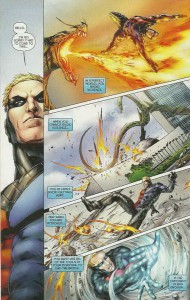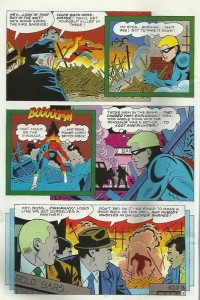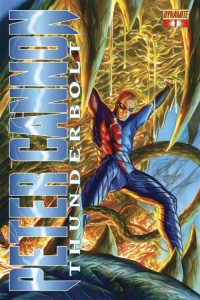Peter Cannon; Thunderbolt
Reviewed by Will Morgan 17-Oct-12
The Dynamite formula has, this time, produced something a bit better than their average.
In the same week as the release of Archie’s New Crusaders, another 1960s super-hero series was retrodden for the next millennium, this time by Dynamite, a company whose output, with the stellar exception of The Boys, has left me pretty indifferent.
Their practise seems to be to acquire lapsed licenses – Shadow, Red Sonja, Green Hornet, the ERB line – and “Madison Avenue” the crap out of them, turning out slick but soulless product with added boobs, giblets and machine-tooled painted artwork. Kind of like Moonstone Comics with a bit more budget and some minimal quality control.
However, that formula has, this time, produced something a bit better than their average.
Thunderbolt was launched in 1965 by Charlton Comics as part of their flawed-but-fabulous attempt to break DC and Marvel’s super-hero monopoly, with the Dick Giordano-helmed “Action hero” line. The character was created by artist/writer Pete Morisi, a veteran cartoonist whose entire output from the 1950s up was produced while working full-time as a cop, which possibly informed his hard-bitten style.
Thunderbolt’s USP was his “Power of Will”, taught to him when he was raised as an orphan at a Tibetan lamasery. By focusing this power, he was able to perform superhuman feats of strength and agility, and heal injury at a phenomenal rate – sort of a proto-Wolverine without the claws and the psychopathy. (Focusing my “Power of Will”, on the other hand, can’t even shift the love handles; maybe I went to the wrong lamasery…) This version has rather more to offer than being a souped-up Logan, though; from the first moment we see him (his debut, a year ago in the series’ timeframe, is considerately flashbacked for us), he’s shown as manipulating forces and energies, enabling him to combat a deadly fire-breathing dragon which has an unexpectedly anti-nuke political stance.
 And, as it turns out, our hero has even bigger tricks and secrets than that up his sleeve; but, as Dr. Song says, “spoilers…”
And, as it turns out, our hero has even bigger tricks and secrets than that up his sleeve; but, as Dr. Song says, “spoilers…”
Unlike New Crusaders, which hews to previously-established continuity, Peter Cannon; Thunderbolt is a complete reboot. We are shown his origin, his history, his supporting cast (lamasery alumnus Tabu, shapely reporter/thorn-in-side Aida Leiva – whose anagrammed name preshadows the re-intro of one of T-Bolt’s classic enemies, this one suspects – and a TV executive and General with their own agendas), and his international empire of “Thunderbolt Schools of Philosophy”. This iteration of Thunderbolt is a reflection of a reflection, a blatant rehashing of Alan Moore’s Ozymandias, who was himself a rehash of the ’60s version; but for all that, it’s presented with admirable clarity and elegance of storytelling, and attractive, vibrant artwork that stands above its paint-by-numbers siblings.

A special bonus for aging nostalgists is the inclusion of a vintage Morisi Thunderbolt story, written and drawn in 1988 but never before printed. Originally intended for DC’s Secret Origins title – the character was leased out to DC at that time – it shows that at 60-something, Morisi’s style was undiminished, even if some of the situations presented therein were dated (Thunderbolt fights a tiger to the death as part of his “graduation” from the lamasery, an eyebrow-raising decision in ’88, let alone a quarter of a century later.). At 18 pages, it’s as long as most “classic” Thunderbolt tales, and is a pleasing retro romp.
It remains to be seen whether lightning can strike twice – though if it lasts 13 issues, it’ll outrun either of the previous series, so the bar’s not high – but so far, the signs are promising.
Tags: Alex Ross, Charlton, Dynamite, Jonathan Lau, Pete Morisi, Steve Darnall, Thunderbolt